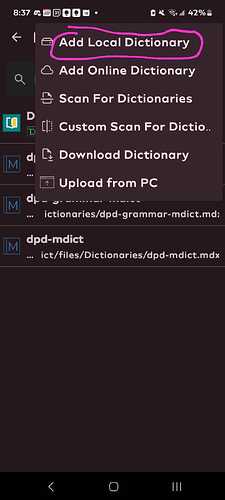ETA: (January 2024)
Successfully added DPD files to DictTango data folder.
Workaround for Android restriction on folder “Android/data/…”: Downloaded app “FV File Explorer.”
Looks like this in GooglePlay store:
-
Click on icon called “Multi-Window”; this opens up two panes so you can do a file transfer.
-
Use one to open up the target folder for DictTango Dictionary: /Android/data/cn.jimex.dict/files/Dictionaries
-
Use the other to open up the source folder for your three DPD files. (I just used the default DOWNLOADS folder.)
In this screen cap, my target folder is on top, my source folder is bottom.
- Select the three DPD files, from source folder
- Drag & drop into the target folder
- There might be a progress bar while it copies over.
To add these dictionary files to the DicTango app:
- Open app & click on “MANAGE DICTIONARIES”
- Click on Menu Icon, (top right) & select “ADD LOCAL DICTIONARY.”
- Navigate to the target folder and select all three DPD files
(/Android/data/cn.jimex.dict/files/Dictionaries)
After adding, all three should show up like:
Ah, I too got the same message as Ven. Sabbamitta when trying MDict:
> "This app is not available for your device. It has been developed for an earlier version of Android."
In case any Android users are still reading:
Seems like next option is to access the DictTango data folder via USB connection to a computer, & dropping the DPD files it via Android File Transfer. (Downloadable onto computer as an application)
If that doesn't work, I might try a 3rd party app - which hopefully doesn't qualify as rooting! before fully giving up & using another Pāli dictionary altogether. Inline lookup isn't a priority on mobile for me, so maybe it's best to be content with that for now...esp. considering the massive paragraphs we've got due next week :sob: :skull: :dizzy_face:




